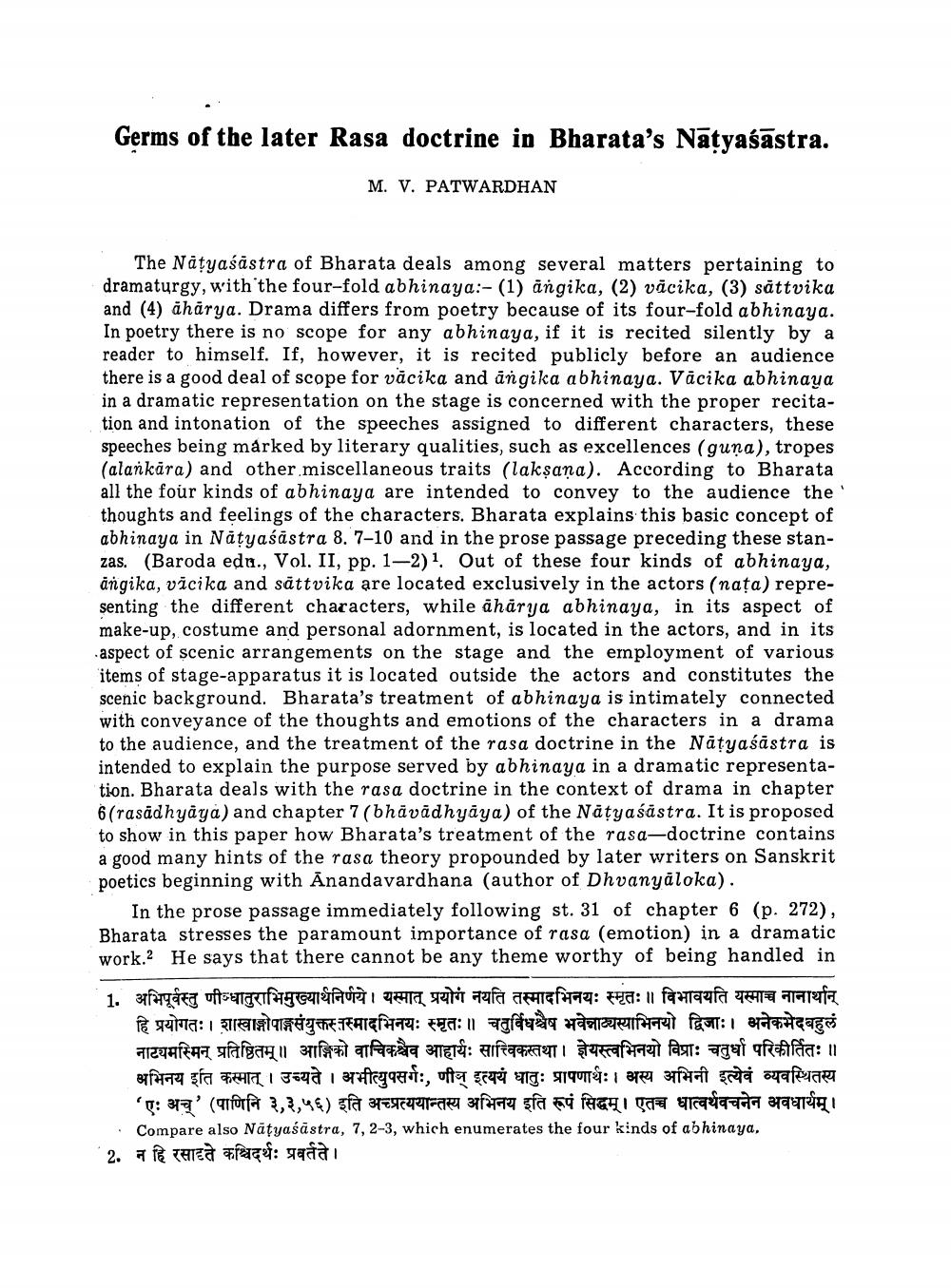________________
Germs of the later Rasa doctrine in Bharata's Natyaśāstra.
M. V. PATWARDHAN
The Natyaśāstra of Bharata deals among several matters pertaining to dramaturgy, with the four-fold abhinaya:- (1) ängika, (2) vācika, (3) sättvika and (4) ahārya. Drama differs from poetry because of its four-fold abhinaya. In poetry there is no scope for any abhinaya, if it is recited silently by a reader to himself. If, however, it is recited publicly before an audience there is a good deal of scope for vācika and angika abhinaya. Vācika abhinaya in a dramatic representation on the stage is concerned with the proper recitation and intonation of the speeches assigned to different characters, these speeches being marked by literary qualities, such as excellences (guna), tropes (alankara) and other miscellaneous traits (laksana). According to Bharata all the four kinds of abhinaya are intended to convey to the audience the thoughts and feelings of the characters. Bharata explains this basic concept of abhinaya in Nătyaśāstra 8. 7-10 and in the prose passage preceding these stanzas. (Baroda edn., Vol. II, pp. 1-2) Out of these four kinds of abhinaya, angika, vācika and sättvika are located exclusively in the actors (nata) representing the different characters, while ahārya abhinaya, in its aspect of make-up, costume and personal adornment, is located in the actors, and in its aspect of scenic arrangements on the stage and the employment of various items of stage-apparatus it is located outside the actors and constitutes the scenic background. Bharata's treatment of abhinaya is intimately connected with conveyance of the thoughts and emotions of the characters in a drama to the audience, and the treatment of the rasa doctrine in the Natyaśāstra is intended to explain the purpose served by abhinaya in a dramatic representation. Bharata deals with the rasa doctrine in the context of drama in chapter 6(rasadhyāya) and chapter 7(bhāvādhyāya) of the Natyaśāstra. It is proposed to show in this paper how Bharata's treatment of the rasa-doctrine contains a good many hints of the rasa theory propounded by later writers on Sanskrit poetics beginning with Anandavardhana (author of Dhvanyaloka).
In the prose passage immediately following st. 31 of chapter 6 (p. 272), Bharata stresses the paramount importance of rasa (emotion) in a dramatic work. He says that there cannot be any theme worthy of being handled in
1. अभिपूर्वस्तु णी-धातुराभिमुख्यार्थनिर्णये। यस्मात् प्रयोग नयति तस्मादभिनयः स्मृतः॥ विभावयति यस्माच्च नानार्थान्
हि प्रयोगतः। शास्वाङ्गोपाङ्गसंयुक्तस्तस्मादभिनयः स्मृतः॥ चतुर्विधश्चैष भवेन्नाव्यस्याभिनयो द्विजाः। अनेकभेदबहुलं नाटयमस्मिन् प्रतिष्ठितम्॥ आङ्गिको वाचिकश्चैव आहार्यः सात्त्विकस्तथा। ज्ञेयस्त्वभिनयो विप्राः चतुर्धा परिकीर्तितः ॥ अभिनय इति कस्मात् । उच्यते । अभीत्युपसर्गः, णीञ् इत्ययं धातुः प्रापणार्थः। अस्य अभिनी इत्येवं व्यवस्थितस्य 'ए: अच्' (पाणिनि ३,३,५६) इति अच्प्रत्ययान्तस्य अभिनय इति रूपं सिद्धम्। एतच्च धात्वर्थवचनेन अवधार्यम् ।
Compare also Națyaśāstra, 7, 2-3, which enumerates the four kinds of abhinaya, *2. a Me Tara Faget: gaaa.




